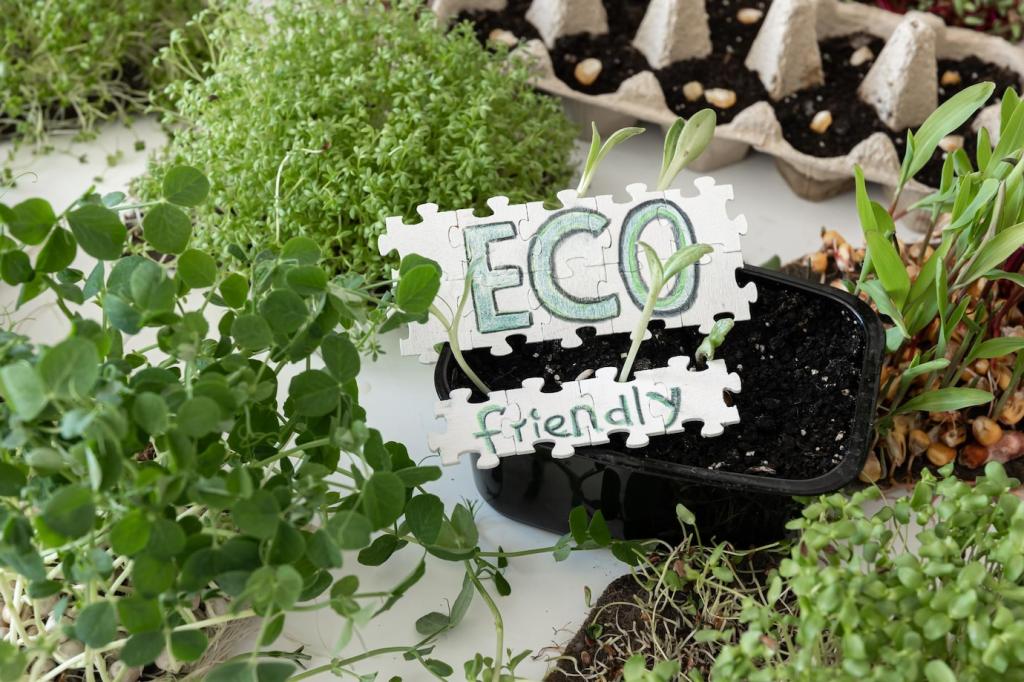Recycled Material Upholstery Care: Practical, Planet-Friendly Guidance
Chosen theme: Recycled Material Upholstery Care. Welcome to a warm, hands-on guide to protecting, cleaning, and celebrating upholstery woven from recycled fibers—without sacrificing comfort, style, or sustainability. Explore proven routines, clever fixes, and community stories that make care simple and rewarding.

Know Your Recycled Fabrics
01
Fiber origins and blends
Recycled upholstery often blends PET from post-consumer bottles, reclaimed cotton, or wool re-spun from offcuts. Blends change care needs: recycled polyester resists stains differently than reclaimed wool. Ask for composition details so your cleaning methods match the fabric’s true behavior.
02
Labels, standards, and care tags
Look for care tags and sustainability standards like Global Recycled Standard or similar labeling. They indicate fiber content and finish types, guiding safe cleaners and temperatures. Keep a photo of the tag for quick reference when spills happen or when scheduling deep cleans.
03
Durability facts that surprise
Many recycled fabrics boast impressive abrasion ratings, rivaling conventional textiles. Tight weaves from recycled PET can shrug off daily wear, yet still prefer gentle tools. Know rub counts and weave density to set realistic expectations about pilling, snag resistance, and long-term maintenance.
Routine Care That Makes a Big Difference
Use a soft-brush vacuum attachment weekly to lift grit that erodes fibers over time. Follow with a lint roller on seams and tufting. This quick ritual keeps recycled PET and reclaimed blends bright, prevents embedded dirt, and reduces the need for aggressive spot cleaning.
Rotate and flip cushions monthly to spread pressure and minimize seam stress. Smooth covers by hand to relax creases that can later become weak points. A five-minute shuffle protects recycled fabrics from flattening and helps zippers, piping, and stitching age gracefully.
Diffuse bright sunlight with sheer curtains to slow fading on reclaimed cotton or dyed recycled fibers. Keep upholstery away from heaters that dry out backings and finishes. Encourage airflow behind sofas to discourage humidity buildup, which can cause odors or mildew over time.
Smart Stain Response for Recycled Upholstery
Blot spills immediately with a clean, white, absorbent cloth to prevent dye transfer and spreading. Work from the edges inward. Rubbing can distort recycled fibers, fuzz the surface, and force stains deeper. Patience and pressure win more battles than scrubbing ever will.


Smart Stain Response for Recycled Upholstery
Start with distilled water to avoid mineral rings. If needed, add a drop of pH-neutral soap and blot again. For oils, sprinkle baking soda to absorb before vacuuming. Always pre-test diluted solutions in a hidden spot to confirm colorfastness and finish compatibility.
Plan a seasonal refresh or sooner if odors, sticky patches, or darkened armrests appear. Begin with a thorough vacuum, then target stains. Only escalate to wet methods when needed, because recycled backings and adhesives can soften if exposed to excessive moisture.
Deep Cleaning Without Damaging Recycled Fibers
High heat can wrinkle or relax recycled fibers, while too much water invites rings and warping. Use minimal moisture, dab not soak, and speed drying with airflow and fans. Avoid steam unless your tag specifically approves it, and always test small, inconspicuous areas first.
Deep Cleaning Without Damaging Recycled Fibers
Prevent pilling before it starts
Reduce friction by avoiding rough throws and scratchy clothing on seats. Rotate preferred lounging spots. Place soft arm covers where elbows rest. Little choices reduce fiber breakage, keeping recycled wool blends and upcycled knits from shedding tiny pills across cushions and seams.
Safe de-pilling tools
Use a gentle fabric shaver or a pill comb with light pressure, working in short strokes. Support the fabric with your free hand to avoid tugging. Finish by vacuuming fuzz away. The goal is tidying surface fibers, not carving into the weave itself.
A denim armchair comeback
An upcycled denim armchair looked tired after a year of movie nights. A careful de-pill, seam check, and light steam from a distance revived the texture. The owner added a soft throw on high-friction spots—simple habits that kept the blue beautifully lived-in, not worn-out.
Freshness, Odors, and Air Quality
Lightly sprinkle baking soda, wait an hour, then vacuum thoroughly with a brush attachment. For lingering odors, place nearby bowls of activated charcoal or open windows for cross-breeze. Avoid heavy fragrances that mask rather than solve, especially on recycled materials with finishes.
Freshness, Odors, and Air Quality
After spot-cleaning, wick out water with dry cloths, then elevate cushions to encourage airflow. A small fan at low speed helps evaporate moisture evenly. Preventing damp pockets reduces odor risk and preserves adhesives or backings used in many recycled upholstery constructions.
Reinforce high-wear zones
Add discreet arm slipcovers or seat protectors cut from matching recycled fabric. A simple basting stitch or Velcro keeps them secure yet removable. Reinforcement preserves original upholstery, spreads wear, and gives you a washable buffer for the busiest seats in the house.
Simple repairs you can master
Tighten a loose seam with a ladder stitch using strong polyester thread. Replace tired zippers with durable coils. Keep a scrap swatch for patching hidden areas. These small, confident fixes turn panic into pride—and postpone costly replacements or invasive reupholstery.
The ocean-plastic loveseat story
A family’s loveseat made from recycled ocean plastic survived a toddler’s marker phase. Blotting, a pH-neutral clean, and patient drying saved the day. Later, a neat seam repair extended its life again. Share your repair wins, and subscribe for monthly tutorials that empower.
